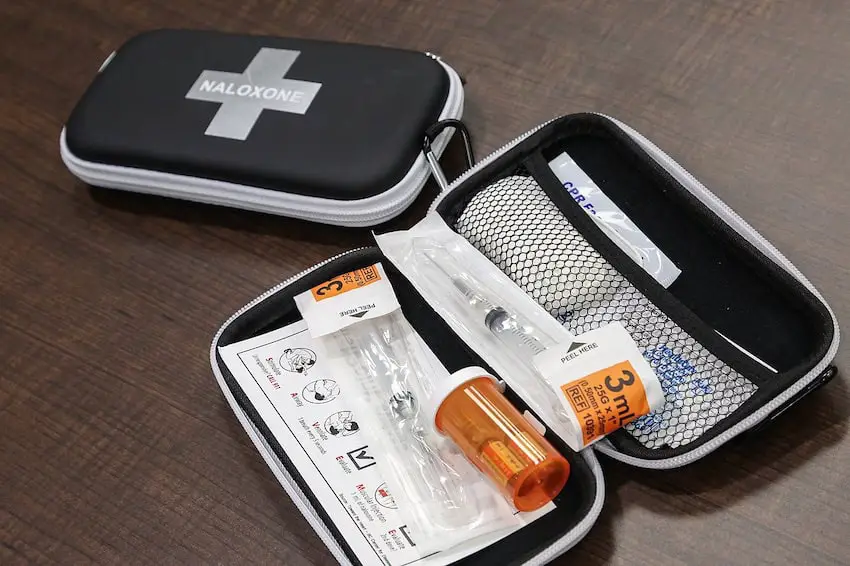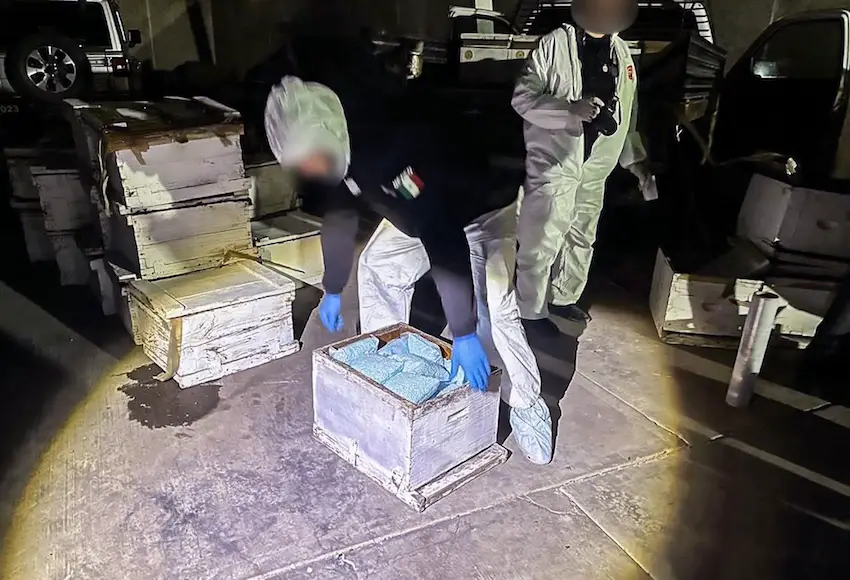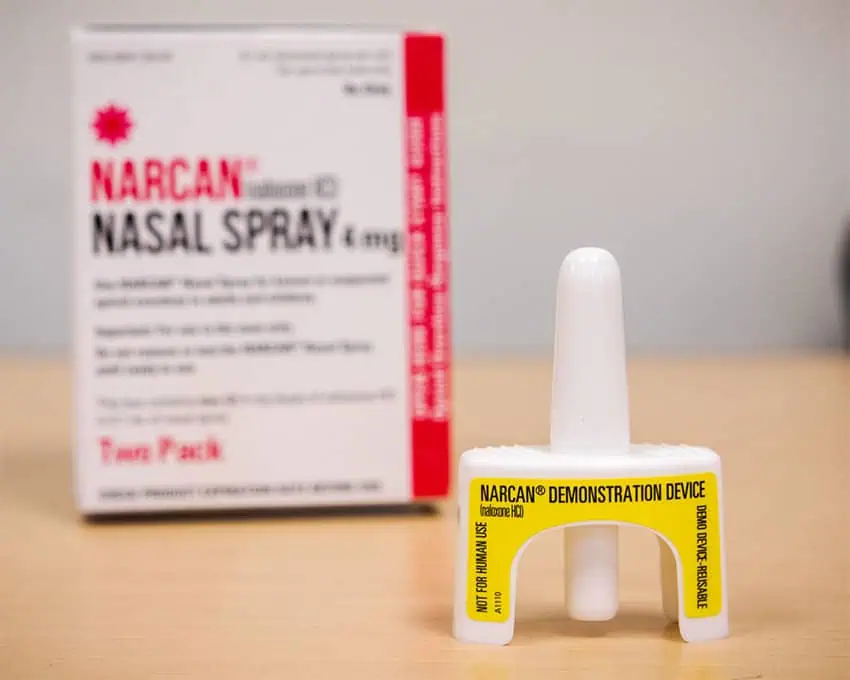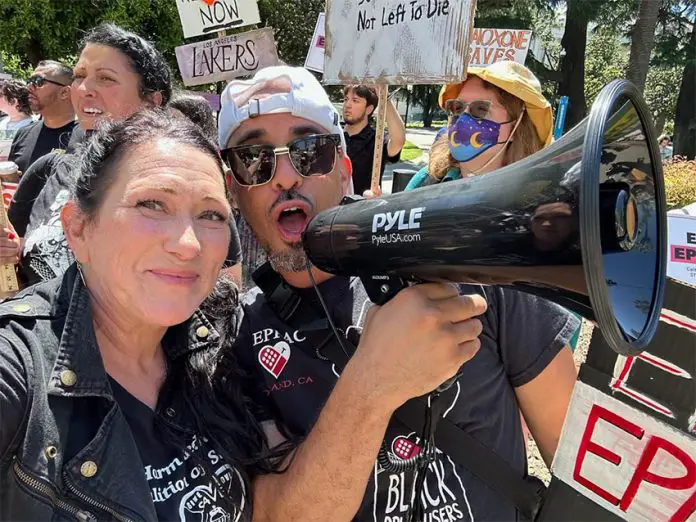Naloxone, also known by the brand name Narcan, is a vital medicine in reversing fentanyl and other opioid overdoses. But it’s not readily available in Mexico due to its classification as a controlled substance.
Enter Tara Stamos-Buesig, sometimes known as the “Naloxone Fairy Godmother.”

The resident of San Diego County is committed to getting naloxone across the Mexico-U.S. border — some might say smuggling it across — into Baja California, where she has made thousands of overdose kits available in border cities in which fentanyl overdoses have risen dramatically. Such cities include Tijuana, Tecate and Mexicali.
“Last year alone, we distributed 100,000 more kits than any other organization in the United States,” Stamos-Buesig told the newspaper Milenio.
Stamos-Buesig is the founder and CEO of Harm Reduction Coalition of San Diego, which receives naloxone through various programs and a wide network of donors — including people who buy it themselves and donate it to the organization.
In the United States, naloxone is widely distributed and considered an essential tool for opioid overdoses. But in Mexico, it’s classified as a psychotropic substance under the General Law of Health, due to its structural similarity to opioids.

“Last year alone, we distributed 100,000 more kits than any other organization in the United States,” Stamos-Buesig told the newspaper Milenio.
Stamos-Buesig is the founder and CEO of Harm Reduction Coalition of San Diego, which receives naloxone through various programs and a wide network of donors – including people who buy it themselves and donate it to the organization.
In the United States, naloxone is widely distributed and considered an essential tool for opioid overdoses. But in Mexico, it’s classified as a psychotropic substance under the General Law of Health, due to its structural similarity to opioids.
This means it is a strictly controlled substance meant to be administered only in hospitals or by first responders, who cannot always obtain the drug.
While naloxone “does have a lot in common with morphine, heroin, oxycodone and all the substances we hear about, it does not have the capacity to activate the receptor site,” says Silvia Cruz Martin del Campo, an addiction and behavioral pharmacology researcher at the prestigious Mexican research organization Cinvestav.

In other words, it does not have any opioid effects; it only blocks the effects of opioids.
Still, in Mexico, naloxone requires a prescription and is not sold at pharmacies, making it nearly inaccessible to those who need it most.
This is expected to change soon in Baja California, where Governor Marina del Pilar Ávila Olmeda recently announced a new program that would make it the first Mexican state to make nasal naloxone available to combat overdoses.
The strategy, she said, includes sending 40 first responders to the United States for training on how to use naloxone in emergency cases. The program also addresses prevention, rehabilitation and reintegrating addicts back into society.
Adrián Medina Amarillas, Baja California’s secretary of health, said the state has been “looking for a mechanism to legally have a sufficient amount of nasal naloxone to use in BC.” It’s part of an overall strategy she described as such: “We want to remove the stigma of treating an addict like a criminal. No, he is a sick person whom we have to help early.”
However, until the state starts implementing naloxone usage programs — and it becomes easily available nationwide — those caught up in the scourge of fentanyl affecting Mexican border cities will have to rely on the “Fairy Godmother” and others who smuggle the overdose antidote across the border.
According to a report by San Diego TV-radio station KPBS, even a health clinic in Tijuana that offers supervised drug usage — so its trained staff can prevent overdoses — can’t easily get its hands on naloxone.
In fact, the PrevenCasa AC clinic in Tijuana’s impoverished Zona Norte neighborhood “often relies on volunteers who essentially smuggle the medicine across the border,” according to an investigation by KPBS border reporter Gustavo Solis.
“When we have to smuggle naloxone from the U.S. to Mexico, there’s something fundamentally wrong with drug policy,” Jaime Arredondo, a professor at the University of Victoria who studies substance abuse, said in the report.
In San Diego, the KPBS report pointed out, naloxone “nasal sprays are available at health clinics throughout the city, inside schools, even in vending machines. First responders regularly carry naloxone and are trained on how to administer the medicine.”
But in Mexico, former President Andrés Manuel López Obrador, in his vigor to downplay Mexico’s role in the fentanyl crisis, blocked efforts by two Morena senators to remove naloxone from the list of psychotropic substances in Mexico. The measure would have allowed its sale in pharmacies and would have funded the Health Ministry to buy naloxone for distribution in communities hard hit by opioid addiction.
One of those two senators, Olga Sánchez Cordero — who had previously served as López Obrador’s Interior Minister — told El Universal newspaper that just as the measure was close to being debated in the Mexican Senate, López Obrador made statements in his daily press conference questioning the validity of naloxone as a strategy for combating Mexico’s opioid crisis.
“Some people might say, ‘This way there will be no deaths’. But will this become a medicine to stop addiction, or is it just prolonging the agony?’” López Obrador said in that press conference on April 11, 2023, suggesting that wider availability of naloxone would merely encourage continued use by addicts rather than recovery.
When asked by El Universal if that press conference sealed her proposal’s fate, Sánchez replied, “I say yes, it did to some extent, because the president’s voice is very strong, very powerful.”
López Obrador also cut funding to nonprofits like PrevenCasa, the KPBS report said, which “significantly impacted the clinic’s ability” to get basic harm reduction supplies, forcing the “Fairy Godmother,” Arredondo and others “to resort to smuggling them across the border.”

In fact, Arredondo said he was once stopped at the border while carrying some 300 vials of naloxone and had to pay US $2,000 to Mexican customs officials in order to cross.
Lourdes Angulo, director of Verter AC an HIV/AIDS prevention nonprofit in Mexicali that works with at-risk populations, including opioid addicts, told Milenio that her clinic receives naloxone “from organizations, activists from the United States, from Canada. We have to bring it across, or sometimes they bring it across themselves.”
Verter AC then gives it to people that need it or distributes it to organizations like Cruz Roja Mexicana, the Mexican Red Cross.
With reports from El Universal, Milenio, La Voz de la Frontera and KPBS
